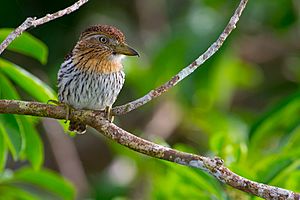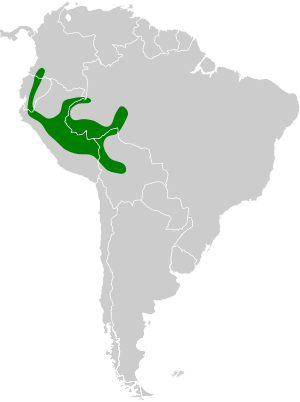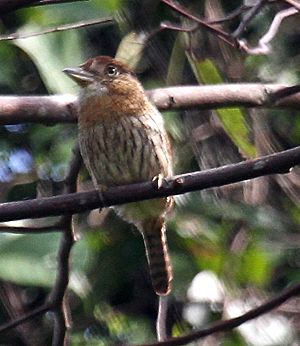Western striolated puffbird facts for kids
Quick facts for kids Western striolated puffbird |
|
|---|---|
 |
|
| Scientific classification | |
| Genus: |
Nystalus
|
| Species: |
obamai
|
 |
|
The western striolated puffbird (Nystalus obamai) is a type of bird. It belongs to the puffbird family, which includes puffbirds, nunlets, and nunbirds. You can find this bird in several South American countries. These include Bolivia, Brazil, Colombia, Ecuador, and Peru.
Contents
About This Bird's Name
Scientists often group animals together based on their features. For the western striolated puffbird, most bird experts agree it is its own unique species. Before, it was thought to be part of another bird, the original striolated puffbird.
But then, scientists discovered it was different enough to be its own species. The original bird was then renamed the "eastern striolated puffbird". However, some groups still consider it a subspecies of the striolated puffbird.
The second part of this bird's scientific name, obamai, honors former U.S. president Barack Obama. This bird is also monotypic, which means it does not have any subspecies of its own.
What the Bird Looks Like
The western striolated puffbird is about 19.8 to 21 centimeters (7.8 to 8.3 inches) long. It weighs between 43 and 47 grams (1.5 to 1.7 ounces). Its head is dark brown with reddish-brown spots and stripes. The back of its neck has a wide, light brown band.
Below this band is a dark stripe. The rest of its upper body is dark brown with reddish-brown spots. Its tail is thin and dark brown with faint reddish-brown stripes. It has a white spot in front of its eye.
The rest of its face is light brown with thin dark streaks. Its chin and upper throat are white. The lower throat is yellowish-brown with fine dark streaks. This color gets lighter towards its belly. The center of its belly is whiter and has no streaks. Its beak is mostly yellowish-green. Its eyes are pale yellowish-brown. Its legs are brown, and its feet are yellowish-green.
Where It Lives and Its Home
The western striolated puffbird lives in the western Amazon Basin. Its range stretches from southern Colombia. It goes south through central Ecuador and central and eastern Peru. It also extends into central Bolivia. Eastward, it reaches into Brazil, south of the Amazon River.
This bird lives in many different places. It likes the edges of humid tropical areas. It also lives in terra firme forests and swamp forests. You can also find it in transitional forests. It usually stays in the middle or top layers of the trees.
It can be found at different heights above sea level. In Colombia, it lives as high as 1,325 meters (4,347 feet). In Ecuador, it can be found up to 1,700 meters (5,577 feet). In Peru, it reaches 1,200 meters (3,937 feet). In Bolivia, it lives as high as 1,850 meters (6,070 feet). This bird does not travel far from its home.
Behavior
Feeding Habits
The western striolated puffbird hunts by waiting on a branch. It waits in the top or middle parts of the trees. When it sees prey, it quickly flies out to catch it. It eats large arthropods, like insects. It also eats small animals such as lizards. After catching its meal, it takes it back to its perch. There, it hits the prey against the branch before eating it.
Reproduction
Scientists have seen western striolated puffbirds breeding in September in Peru. They have also seen breeding activity in October in Colombia. This bird builds its nest in a hole. The hole is at the end of a tunnel. The tunnel is dug into an earthen or sandy bank. It is believed that these birds lay three or four eggs.
Vocalization
The western striolated puffbird has a soft, sad song. It sounds like "whip, whi-wheeu, wheeeeeuu". The song has a special rhythm. It first goes up in pitch, then falls after a short pause. The bird usually sings shortly after sunrise or just before sunset. Often, the male bird sings first. The female quickly follows, singing at a slightly lower pitch.
Conservation Status
The IUCN (International Union for Conservation of Nature) looks at how many of these birds there are. They consider the striolated puffbird as one species. They have assessed it as being of "Least Concern". This means it is not currently in danger of disappearing.
The bird lives across a very large area. Scientists have not counted the exact number of these birds. However, they believe the population might be getting smaller. It is considered rare in some places. In other areas, it is quite common.
See also
 In Spanish: Buco estriado occidental para niños
In Spanish: Buco estriado occidental para niños
- List of things named after Barack Obama
- List of organisms named after famous people (born 1950–present)


